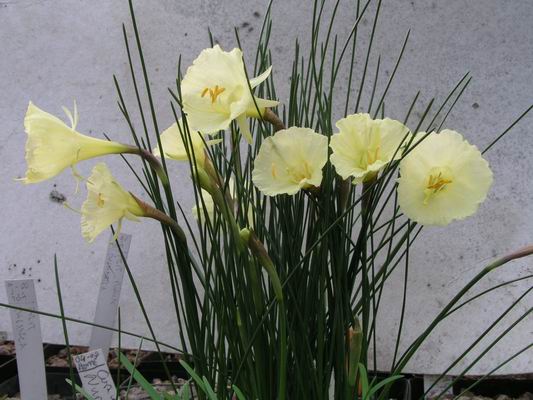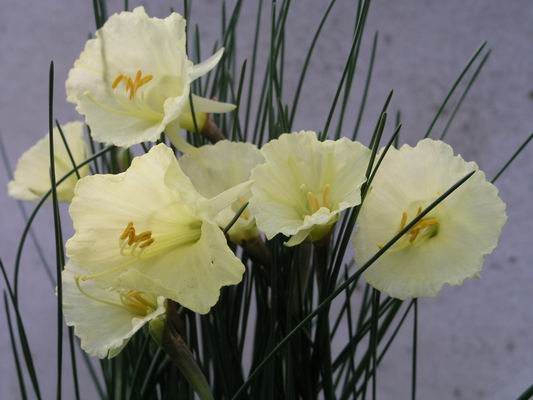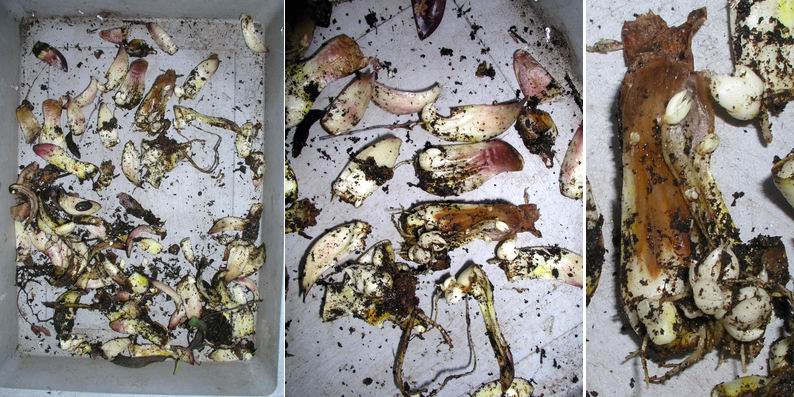|
BULB LOG 51 - 21st December 2005

Bulb house and snow
The snow arrived again last Friday giving us that seasonal look a week too early for Christmas. I am not worried about leaving the snow on the glass roofs as long as it does not get too deep, if it does continue to snow then I would scrape it off as the build up of weight can cause these flimsy aluminium structures to collapse. The snow does cut down the light to the bulbs but as the temperatures are usually close to freezing they are not inclined to grow anyway.

Snow on the roof
The narcissus come to no harm under these conditions as they enter a state of suspended animation waiting for the temperatures to rise again.
However by Monday the snow had been washed away as the snow turned to rain and now we have blue skies and sunshine again.

Narcissus romieuxii yellow.
As much as I try to cut back on the number of Narcissus we grow in pots I just cannot resist them, especially when some of our seedlings turn out like this one.

Narcissus romieuxii yellow seedling
It is the darkest yellow romieuxii that we have raised yet and it is a good increaser; this potful represents the increase from a single bulb selected out in 2002. It also that most desirable characteristic that is essential for a good selection, that is, it flowers freely every year. With the combination of these features, good increaser, flowers freely, good sized deep yellow flowers on short stems it is one that I think I will have to name. I am always worried about the number of plants that receive cultivar names, there seems to be a never ending procession of them appearing every year. I do not think we should worry too much provided that we select only the best. If we raise a good plant, like the above, and I am going to distribute it among other growers, I always give it a name - this way the plant is traceable and people get to know. If I distribute a plant without a name and it increases well for others and they in turn distribute it, then some where along the line some one will give it a name and m
y worry is: what if two people along that chain of distribution decide to give it a different name? That is how we can get into confused mess with plant cultivar names and identification.

Narcissus romieuxii seedling
Just to show how temptation is always there, here is another seedling raised from Narcisus 'Camoro', which is a fertile hybrid between N cantabricus monophylus and N. romieuxii. While the flowers of 'Camoro' are an off white, this seedling has that sparkling crystalline white corona which is widely flared at the mouth - I am now waiting to see how well it will increase and if it will flower as freely as its seed parent. I should add that I have no idea what the pollen parent is, it could have selfed or it may have been crossed to another form. I am sure that you can see the dilemma that I am in; how can I cut back when all these lovely new seedlings keep appearing.

Splitting lily bulb
I am sure you will all remember that poor lily bulb that I showed a few logs back sitting above the surface of the soil. I finally took pity on it and got around to lifting the clump.
When I lifted it I discovered that what was a single bulb when it was planted had now increased to a tangled mass of 10 bulbs.

Split lily bulb
It took the application of two forks and not a little force to prise them apart without doing too much damage to the bulbs or the fat semi-permanent roots.

Lily scales
The top bulb, that has spent too long out of the ground, had suffered some rot to its centre but, yet again bulbs amaze me, as rather than being set back by this mistreatment, all the scales have started to form small bulbs. Some have a small bulb forming at the base and others have bulbils forming all along the length of the scales - it just shows how determined bulbs are to survive and have adapted a mechanism to ensure their survival and increase no matter what the conditions are. This feature of scale budding has been capitalised on by growers for many years as a way of increasing lilies by removing some of the outer scales of healthy bulbs, setting them in a damp medium and waiting for the bulbils to form from the latent shoots.

Crocus seed germinating
As part of my on-going cruelty to bulbs, I lifted this crocus seedling,which is just germinating, to observe where the corm forms on the root system. It is clear even at this stage that the corm forms just a short distance below where the seed is planted. You can see where the stem dropping down from the seed changes from white: that is the point where the corm is now forming. I will follow the progress of this seedling as it goes through its first year of growth.

Crocus imperati suaveolens
Crocus imperati suaveolens is flowering well ahead of its normal time, I never remember it being this far advanced in December before. I am always surprised by the flowers, which are not very colourful when in closed bud like this, but have a strong and attractive colour when they are fully open. I also notice that many of the leaves on this form have a kink in them towards the end - this occurs every year and I wonder if it is typical of this species or if it is just this clone that I am growing, or is it a reaction to the growing conditions?

Crocus laevigatus
I showed the outside of the flowers of Crocus laevigatus last week and this one managed to open in the warmth of today's sunshine now the snow has gone, to reveal the white anthers.

Snowy scene
The wintry conditions were swept away by the rains of Sunday night and we are enjoying clear blue skies and milder conditions again as I write this log, while travelling on a train from Fife back to Aberdeen, the sun is low in the sky across the estuary of the great river Tay, I wish I had remembered to bring my camera. I will leave you with another seasonal snowy picture of the garden taken last weekend.
^ back to the top ^
|

